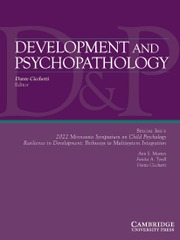Crossref Citations
This article has been cited by the following publications. This list is generated based on data provided by
Crossref.
Gosselin, Catherine
2000.
Fonction des comportements parentaux: révision de la notion de sensibilité maternelle.
Psicologia: Teoria e Pesquisa,
Vol. 16,
Issue. 2,
p.
103.
Lakatos, K
Toth, I
Nemoda, Z
Ney, K
Sasvari-Szekely, M
and
Gervai, J
2000.
Dopamine D4 receptor (DRD4) gene polymorphism is associated with attachment disorganization in infants.
Molecular Psychiatry,
Vol. 5,
Issue. 6,
p.
633.
Hesse, Erik
and
Main, Mary
2000.
Disorganized Infant, Child, and Adult Attachment: Collapse in Behavioral and Attentional Strategies.
Journal of the American Psychoanalytic Association,
Vol. 48,
Issue. 4,
p.
1097.
Ann Easterbrooks, M.
Biesecker, Gretchen
and
Lyons-Ruth, Karlen
2000.
Infancy predictors of emotional availability in middle childhood: the roles of attachment security and maternal depressive symptomatology.
Attachment & Human Development,
Vol. 2,
Issue. 2,
p.
170.
Shaw, Daniel S.
Bell, Richard Q.
and
Gilliom, Miles
2000.
A Truly Early Starter Model of Antisocial Behavior Revisited.
Clinical Child and Family Psychology Review,
Vol. 3,
Issue. 3,
p.
155.
Ahnert, Lieselotte
Lamb, Michael E
and
Seltenheim, Katrin
2000.
Infant–care provider attachments in contrasting child care settings I: Group-oriented care before German reunification.
Infant Behavior and Development,
Vol. 23,
Issue. 2,
p.
197.
Ward, Mary J.
Lee, Shelley S.
and
Lipper, Evelyn G.
2000.
Failure-to-thrive is associated with disorganized infant-mother attachment and unresolved maternal attachment.
Infant Mental Health Journal,
Vol. 21,
Issue. 6,
p.
428.
Carmichael Olson, Heather
O'Connor, Mary J.
and
Fitzgerald, Hiram E.
2001.
Lessons learned from study of the developmental impact of parental alcohol use.
Infant Mental Health Journal,
Vol. 22,
Issue. 3,
p.
271.
Fish, Margaret
2001.
Attachment in low‐SES rural Appalachian infants: Contextual, infant, and maternal interaction risk and protective factors.
Infant Mental Health Journal,
Vol. 22,
Issue. 6,
p.
641.
Cassidy, Jude
and
Mohr, Jonathan J.
2001.
Unsolvable fear, trauma, and psychopathology: Theory, research, and clinical considerations related to disorganized attachment across the life span..
Clinical Psychology: Science and Practice,
Vol. 8,
Issue. 3,
p.
275.
Cassidy, Jude
2001.
Truth, lies, and intimacy: An attachment perspective.
Attachment & Human Development,
Vol. 3,
Issue. 2,
p.
121.
Espinosa, Michael
Beckwith, Leila
Howard, Judy
Tyler, Rachelle
and
Swanson, Krista
2001.
Maternal psychopathology and attachment in toddlers of heavy cocaine‐using mothers.
Infant Mental Health Journal,
Vol. 22,
Issue. 3,
p.
316.
2001.
Child-care and family predictors of preschool attachment and stability from infancy..
Developmental Psychology,
Vol. 37,
Issue. 6,
p.
847.
Kobak, Roger
Little, Michelle
Race, Eleanor
and
Acosta, Michelle C.
2001.
Attachment disruptions in seriously emotionally disturbed children: Implications for treatment.
Attachment & Human Development,
Vol. 3,
Issue. 3,
p.
243.
Fearon, R. M. Pasco
and
Mansell, Warren
2001.
Cognitive perspectives on unresolved loss: Insights from the study of PTSD.
Bulletin of the Menninger Clinic,
Vol. 65,
Issue. 3,
p.
380.
Benoit, Diane
Madigan, Sheri
Lecce, Sandra
Shea, Barbara
and
Goldberg, Susan
2001.
Atypical maternal behavior toward feeding‐disordered infants before and after intervention.
Infant Mental Health Journal,
Vol. 22,
Issue. 6,
p.
611.
Schore, Allan N.
2001.
The effects of early relational trauma on right brain development, affect regulation, and infant mental health.
Infant Mental Health Journal,
Vol. 22,
Issue. 1-2,
p.
201.
AHNERT, LIESELOTTE
and
LAMB, MICHAEL E.
2001.
The East German Child Care System.
American Behavioral Scientist,
Vol. 44,
Issue. 11,
p.
1843.
Koós, Orsolya
and
Gergely, György
2001.
A contingency-based approach to the etiology of 'disorganized' attachment: The 'flickering switch' hypothesis.
Bulletin of the Menninger Clinic,
Vol. 65,
Issue. 3,
p.
397.
Stams, Geert-Jan J. M.
Juffer, Femmie
and
van IJzendoorn, Marinus H.
2002.
Maternal sensitivity, infant attachment, and temperament in early childhood predict adjustment in middle childhood: The case of adopted children and their biologically unrelated parents..
Developmental Psychology,
Vol. 38,
Issue. 5,
p.
806.

